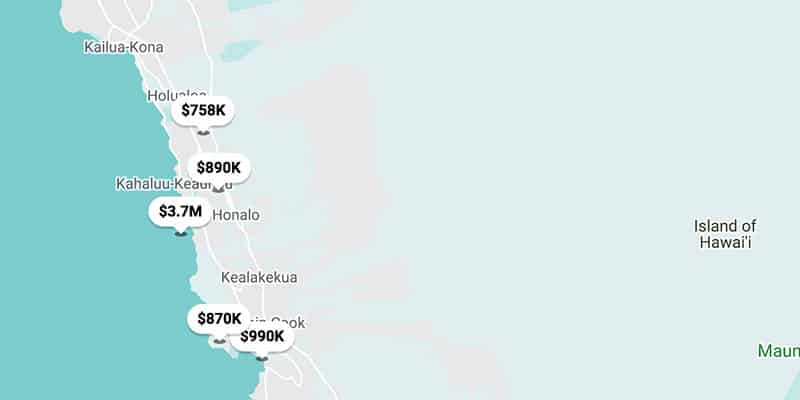LOOKING TO BUY? Utilize these 15-STEPS to help simplify the home buying process and gain a better understanding of how to buy your Big Island home with Kona REALTOR®, Penn Henderson (RS).
Utilizing these 15-steps will help wrap your mind around things. If you have any questions while reading through this, feel free to reach out to Kona Realtor®, Penn Henderson. And should you ultimately decide to buy property here on the Big Island, you would be hard-pressed to find a more committed and skilled professional to partner with than Penn.
Step # 1
Get Organized
Getting organized ahead of time will greatly influence your ability to efficiently find (and ultimately purchase) your ideal property. Begin with the following:
Determine Your Needs: How much space do you need? What areas, subdivisions, or condo complexes might you be interested in? What about your lifestyle? Would you like to be in close proximity to the beach, town, or hiking trails? What type of climate do you prefer? Do you like it warmer, cooler, sun-drenched, dry, rainy, etc.? One of the great things about living on the Big Island is that its diverse climate zones offer something for almost everyone. Penn can help with this initial research with just a few quick questions.
Search the Hawaii MLS: Have some fun with some preliminary online searches using the Hawaii MLS. Check into what prices homes are selling for with different features and in various areas to help give you an idea of what you are looking for. Gaining some familiarity will help later on during your initial talk with Penn. | Search Hawaii MLS |
*TIP: Quickly create your own login so you can add your selected “favorite” properties to your personal portfolio and be able to review & compare them at your convenience.

Estimate Your Budget: Use the mortgage calculator to determine what your monthly mortgage payment would be if you were to purchase any of the homes that interest you. Make some additional estimates for property taxes, utilities, and association dues to see if this fits into your budget. Fannie Mae recommends buyers plan to spend less than 28% of their total income on housing. So, if your total household income is $10,000 per month, you should aim for properties with total monthly housing expenses not exceeding $2,800.
Familiarize Yourself with the Market: Once you have narrowed down your search to certain areas and property types, study the recent sales and active listings. Understanding the real estate market in terms of Days on the Market and Median Sales Price will give will help you when it comes time to submit an attractive offer.
Define a Timeframe: When would you like to take ownership of the property? Is buying a home contingent upon the selling of your current home? Keep in mind, the typical time it takes to close on a purchase in Hawaii averages about 45-days. Many factors can add to this such as certain types of loans requiring additional review time (a VA Loan for example).
Your Financial Documents: Locate and organize your tax returns, pay stubs, and if applicable, Veteran’s Administration eligibility documentation. Having these items ready to go will help expedite things down the road when obtaining loan pre-approval.
Step # 2
Talk with Penn
It’s been said that Realtors are a mirror of their clients and this agent-client synergy is an important ingredient for a smooth and successful home buying experience.
An introductory meeting with Penn is a great place to start – and is an opportunity for everyone to ask questions, get acquainted, and begin defining objectives & goals to potentially move forward with.
- Did You Know?
As a result of the recent settlement with the National Association of Realtors, a formal Buyer’s Representation Agreement will become a critical part of the buying process moving forward. Contact Penn for a better understanding of how this may impact you.
Step # 3
Get Pre-Approved for a Loan

Upon meeting with Penn and formulating a plan with defined goals and objectives, the next step is for you to meet with a licensed Hawaii mortgage broker or lender. Start with your current bank, but make sure to check out competitor banks as well – you might find better loan rates by simply shopping around a bit. They will help you determine what you can afford and explain the different types of loan options that are available to you.
To get pre-approved for a mortgage you will need to get some paperwork ready: Pay stubs, W-2’s, bank account statements, tax returns for the past two years, credit lines, and names and addresses of any landlords over the past two years.
- Helpful Tip:
Try to stick with a local, Hawaii-based lender familiar with the intricacies of Hawaii Real Estate to help fund your loan and get to closing on time as specified within the contract. Closing late can cost you money every day the transaction is extended should the seller charge you daily interest.
Step # 4
Look at Homes

Once you receive loan pre-approval, Penn will meet with you again in the office (or virtually) to review homes available on the MLS that meet your needs and are within your budget. Aim to identify a handful of homes you would like to tour (~6 is a good starting point).
Sometimes properties are available to view with short notice, especially true for vacant properties, but in many cases, 24-hour notice is required when occupied.
Penn will personally guide you through each property, discussing your preferences and facilitating questions along the way.
- Off Island?
If you are off-island and unavailable for an in-person showing, Penn can arrange for a live guided virtual tour with you.
If you consider any of the properties a strong contender, Penn can schedule a second showing if you would like. Of course, if additional properties become newly listed during the search that are appealing, those can be added to the mix as well. Once you have found a property that you would like to move on, Penn will work together with you in crafting a strong purchase offer.
Step # 5
Make an Offer
Before making an offer, Penn will provide you with a Comparative Market Analysis (CMA) of the property, identifying comparable properties to the one you have chosen. You can use this information to evaluate recent selling prices of similar properties to help guide your decision on a price you would like to offer for your chosen property.
Once you are ready and have determined a price to submit as an offer to purchase, Penn will prepare the contract (a standard 14-page Purchase Contract by the Hawaii Association of Realtors) and review the offer details with you to ensure everything is accurate and understood clearly. You will then sign the Purchase Contract and Penn will submit it to the listing agent (seller’s agent).
Sometimes a response will be received quickly (within a few hours), and sometimes it could take several days before hearing anything. You can expect one of three things to happen:
The seller accepts your offer.
If this is the case, congratulations – you now move on to Step 7 – “Open Escrow”
The seller rejects your offer.
If this happens, Penn can work with you on submitting a new offer if you would like.
The Seller makes a counteroffer.
You can either accept their counteroffer, or you can respond with your own counteroffer. If this is the case, you have effectively moved on to Step 6 – “Negotiate”
If an offer or any counteroffer(s) failed to result in a signed Purchase Contract by both buyer and seller, then it is time to go back to Step 4 and review other property contenders or look at other homes on the market that you may have not yet seen.
Step # 6
Negotiate

BE PREPARED: It is not unusual to go back and forth with the seller a few times on price and selling conditions. Penn will be your advocate here and try to get you, his client, as much as possible for your money while being fair and respectful to the seller and their real estate agent.
BE PATIENT: Sometimes the seller may take time to respond as they evaluate your offer – or as they may be taking time to draft a counteroffer. Penn will make sure to stay in touch with the seller’s agent to keep apprised of the status. Be patient, stay composed, remain positive. If you receive a counter offer not to your liking, Penn will work with you on formulating a counteroffer of your own to present to the seller.
Step # 7
Open Escrow
Once an agreement on contract terms is reached with the Seller, you are under contract, which is referred to as opening escrow. A neutral – impartial – 3rd party company is used to administer the transaction, known as an escrow company. The escrow company plays a number of important roles during a transaction:
ORDERS A PRELIMINARY TITLE REPORT and has a title officer review the report for any potential title issues, such as liens and other issues that need to be resolved before you take ownership.
ORDERS THE DEED (conveyance document) from an attorney, which is the legal document making the transfer of ownership official.
HOLDS YOUR DEPOSITS and the final payment in their bank account until recordation.
PREPARES A FINAL CLOSING STATEMENT (outlining all costs itemized) and other documents requiring your review and signature.
Typically, the escrow process usually takes 45 to 60 days to complete. Penn will work with you throughout the process to keep you informed, answer questions, and assist you in sourcing professionals to help you with the process (inspectors, surveyors, and other experts who can help with situations as needed).
- Helpful Tip:
Be prepared and on alert during the escrow process. There will be many documents needing your attention (review, signatures, etc.) that are time-sensitive, requiring your response in a timely manner.
Step # 8
Initial Deposit
In most cases, the buyer (you) will pay an initial deposit shortly after opening escrow. You can wire funds, provide a cashier’s check, or write a personal check. There are no rules as to how much the initial deposit should be, but around 1% of the purchase price is not uncommon – which has been included and agreed upon in the purchase contract.
Step # 9
Home & Termite Inspections
It is recommended that you hire professional home and termite inspectors to do a thorough inspection of the property to check for issues, even if the property is brand new. If the inspector identifies issues, you have some options to consider:
- Request Seller to fix, though Seller is not obligated to fix.
- Request a credit from Seller, though Seller is not obligated to accept.
- A combination of 1.) and 2.) – Credit & Repair request.
- Accept inspection results and not request anything from Seller.
- Cancel the contract, within certain contingency deadlines, and get your initial deposit back, except the cost of the home inspection.
If live termites are found, the Seller has to pay for treatment to get rid of them. If there is damage to the property that is considered material, you may cancel the purchase contract based on later discovered information within certain contingency timeframes and be refunded any deposits paid into escrow.
Normally, the buyer pays for the home inspection and the seller pays for the termite inspection – with the details being specified in the purchase contract. Generally, you want to get these inspections completed as soon as possible upon opening escrow. Penn will work with you on the timing as they relate to deadlines that you need to be aware of.
Step # 10
Second Deposit
If you decide to proceed with the purchase after the inspections, this is normally the time you will pay the 2nd deposit. There are no rules as to how much the 2nd deposit should be, but around 2.5% of the purchase price is not uncommon – all agreed upon in the purchase contract.
Step # 11
Review Documents

BRACE YOURSELF: You will be inundated with many important documents along the way.
Preliminary Title Report– Typically, a few days after opening escrow you will receive a preliminary title report, ordered and delivered by the escrow company, outlining who are the owners on the title and if there are any liens or other issues with the title that must be resolved before transferring ownership. The escrow company typically works with the Seller to resolve any title issues.
Seller’s Real Property Disclosure Statement – This is a standard 5-page document with several questions Seller has to complete. The questions will be answered with Yes, No, NTMK (not to my knowledge), or NA (not applicable). When the Seller answers Yes to a question, Seller has to write an explanation. If Seller’s Disclosure reveals something you are not comfortable with, you may cancel the contract, within certain contingency deadlines, and get your deposit(s) back.
Condo Documents (applicable for condos only) – Ordered and paid by Seller. This is typically a lot of documents, including the declaration, bylaws, house rules, meeting minutes from board meetings, association insurance summary, financial statement, reserve study, project information form (a document filled out by the condo’s managing agent answering questions such as if there are any owner’s delinquent on paying their maintenance fees if there is any litigation going on, what maintenance fees cover, etc.) If the condo documents reveal something you are not comfortable with, you may cancel the contract and get your deposit(s) back.
Survey (applicable to houses only) – Ordered and paid by Seller. The Survey is done by a Land Surveyor licensed in Hawaii. The survey involves marking property corners and creating a map that shows the layout of the land and any man-made improvements on the land such as house, pool, fences, walls, garage, roof overhang, etc. The primary objective of the survey is to confirm if there are encroachments across property lines onto neighboring properties. If an encroachment – such as a fence running on your neighbor’s lot – is less than 6 inches, that is considered de minimis and does not require an encroachment agreement. If an encroachment is more than 6 inches, the Buyer can decide to accept such encroachment or instruct Seller to remedy the issue, which can be done by a) Seller making a written encroachment agreement with their neighbor or b) Seller removes the encroachment, which has to be acceptable to the Buyer.
Step # 12
The Appraisal
If you are getting a mortgage, the lender will order an appraisal of the property. If you are a cash buyer, no appraisal is required. Banks will lend you a certain percentage based on the appraised value, not based on the purchase price.
Example: If you purchase a property for $1,000,000 with loan terms specifying an 80% loan to value (LTV), then if the appraisal comes in at $990,000, the bank will only lend you 80% of $990,000.
The appraisal fee is paid by you, the buyer – which your mortgage broker should discuss with you.
Step # 13
Final Walk Through
A few days before the property closes at recording – the date you take ownership – you will typically have the opportunity for a final walk-through of the property to ensure it is in the same condition as it was during the home inspection. You will want to make sure the Seller has removed garbage and personal belongings that are not part of the contract. If items were negotiated with the Seller to be fixed after the home inspection – ensure such issues have indeed been fixed.
Step # 14
Final Signing
The Deed (the legal document that transfers ownership from one person to another) must be signed in front of a public notary, usually occurring at the office of the escrow company.
If you are out of town, signing can be accomplished at the escrow company’s office on the mainland, a mobile notary, or at a US embassy in whatever country you may be present. There are other ways to handle the process too, but these are the most common ways.
There are several other documents that need to be signed in addition – shortly before recordation, though not in front of a notary. These include Tentative Buyer Statement, Preliminary Title Report, Conveyance Tax Certificate, Termite Inspection Report & Satisfaction Waiver.
The original signed deed and all other signed documents, in addition to the final balance of the purchase price plus closing costs must be with the escrow company by noon, 2 business days prior to recordation (closing).
Once everything is in order, the escrow company will complete the process by submitting your transaction to the Bureau of Conveyances on Oahu for official recording.
Step # 15
Record Ownership & Get Your Keys!

On the date of recordation, escrow will be informed by the Bureau of Conveyance (the government office where the deed is recorded) that the new deed has recorded. Escrow will notify both Penn and the Seller’s agent (typically before 9:00 am) that it has successfully recorded.
It is official – you are now the legal owner – congratulations! You will get the property keys and can move in.

